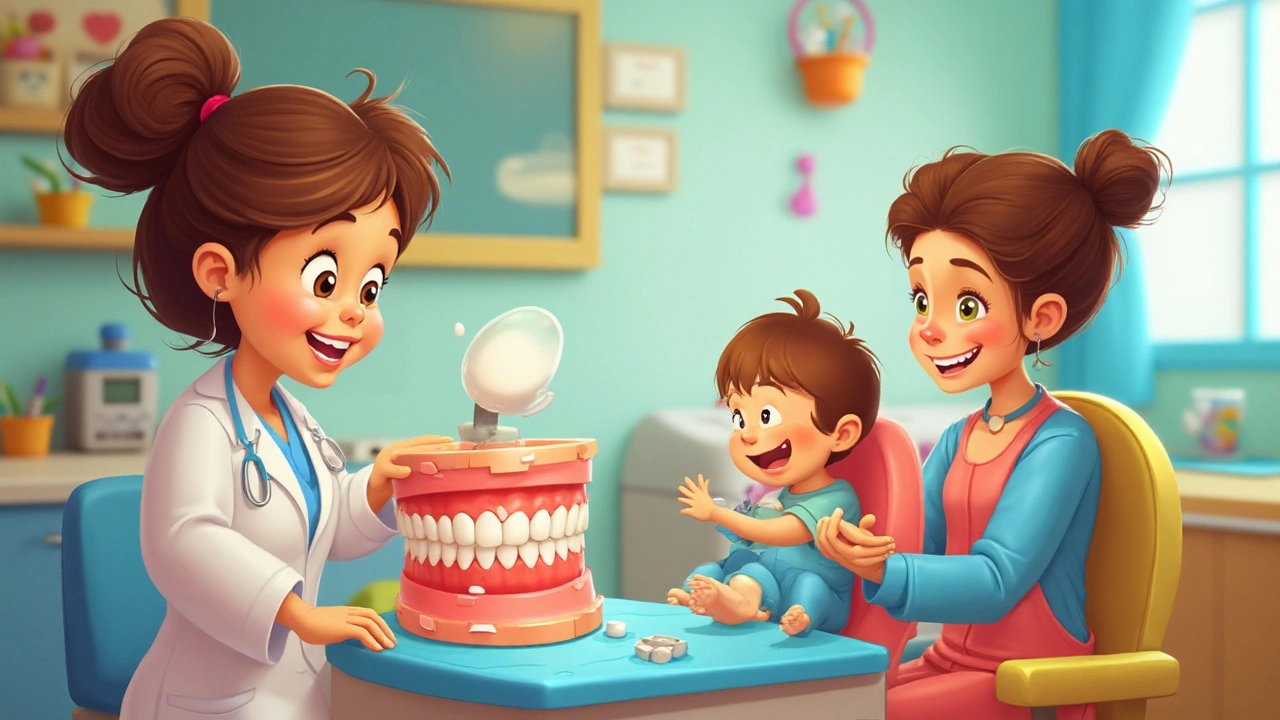Pediatric Dentist is a dental specialist who cares for children’s oral health from birth through adolescence and focuses on early interventions that prevent future problems. When a newborn starts to fuss from a sore gum, most parents wonder if a pediatric dentist can help. The answer is a resounding yes: these professionals combine clinical expertise with child‑friendly techniques to ease teething discomfort while safeguarding long‑term oral health.
What Is Teething and Why Does It Hurt?
Teething is the process where a baby’s first set of teeth, known as milk teeth, erupt through the gums. The event typically begins around four months of age, peaks at six to eight months, and can last until the child is two or three years old. As a tooth pushes through the soft tissue, pressure, inflammation, and minor bleeding create sensations that most infants describe as pain.
Teething Pain refers to the discomfort, irritability, and sometimes low‑grade fever that accompany the eruption of primary teeth. While the intensity varies-some babies sleep peacefully while others cry nonstop-the underlying cause is the same: the gum tissue is being stretched and compressed.
Why Pediatric Dentists Get Involved Early
Unlike general dentists who may see children only after the first teeth appear, pediatric dentists are trained to intervene during the earliest stages of oral development. Their role includes:
- Performing a thorough Oral Health Assessment that records gum condition, tooth eruption pattern, and any signs of infection.
- Identifying abnormal pain signals that could indicate deeper issues such as dental caries or gum disease.
- Educating parents on safe pain‑relief strategies and when to seek medical attention.
How a Pediatric Dentist Evaluates Teething Pain
The initial visit usually lasts 15-20 minutes. The dentist examines the mouth with a small mirror, checks for swelling, and records the child’s developmental milestones. Milestones-like rolling over or babbling-help gauge whether the infant’s pain response is typical for their age.
If the dentist spots signs of infection, they may recommend a short course of antibiotics. Otherwise, the focus shifts to soothing the discomfort with evidence‑based methods.
Non‑Pharmacologic Relief Options
Non‑Pharmacologic Relief encompasses all drug‑free techniques that reduce gum pressure and calm the infant. Popular choices include:
- Cold teething rings or chilled (not frozen) washcloths that numb the gums.
- Gentle gum massage with a clean finger-creates pressure that can ease swelling.
- Distraction through play, singing, or soothing sounds-helps shift focus away from pain.
- Acupressure points on the cheek (as recommended by pediatric dental associations).
These methods are low‑risk, inexpensive, and can be used daily. A pediatric dentist will show parents the correct technique for each.
Pharmacologic Relief Options
Pharmacologic Relief refers to medications that target pain pathways or reduce inflammation. The dentist may suggest:
- Acetaminophen (paracetamol) at age‑appropriate doses-first‑line for mild to moderate pain.
- Ibuprofen for infants over six months when swelling is pronounced.
- Topical anesthetic gels (e.g., lidocaine 2%) applied sparingly-only under professional guidance.
Guidelines stress careful dosing: too much medication can cause liver or kidney stress. Pediatric dentists provide a dosing chart calibrated to the child’s weight and age.

Comparison: Non‑Pharmacologic vs Pharmacologic Relief
| Approach | Typical Use | Pros | Cons |
|---|---|---|---|
| Non‑Pharmacologic | Daily or as needed | No medication side‑effects; promotes bonding | May provide only mild relief |
| Pharmacologic | Short‑term, when pain disrupts sleep or feeding | Rapid, measurable pain reduction | Risk of dosing errors; possible stomach upset |
Parental Guidance and Education
Parental Guidance is the process by which dental professionals teach caregivers safe, effective pain‑management techniques. During the visit, dentists hand out:
- A one‑page chart showing dosage calculations for acetaminophen and ibuprofen.
- Tips on how to clean and sterilize teething toys.
- Red flags that warrant a pediatrician’s review-persistent fever, excessive drooling, or refusal to eat for more than 24 hours.
Research from the Australian Dental Association (2023) shows that families who receive clear instructions report 40% less nighttime crying during teething peaks.
Preventive Strategies for Long‑Term Oral Health
While teething itself cannot be prevented, pediatric dentists can lay the groundwork for healthier teeth later on.
Fluoride Varnish is a topical fluoride coating applied to newly erupted teeth to strengthen enamel and reduce decay risk. It’s safe for infants and can be placed during a routine check‑up.
Bite Appliances such as soft night guards are sometimes used for children who experience severe grinding during teething, helping to protect fragile enamel.
Good oral hygiene habits-wiping gums with a soft, damp cloth after feeds-also reduce bacterial load, making the teething process less uncomfortable.
Collaboration with Pediatricians and Child Development Experts
Teething pain often overlaps with other developmental milestones, like sleep pattern changes or language bursts. Pediatric dentists routinely share findings with a child’s pediatrician, ensuring a holistic approach. When a baby shows signs of excessive irritability beyond typical teething, the dentist may refer the family to a child development specialist to rule out sensory processing issues.
What Parents Should Do Next
After reading this guide, the practical next steps are simple:
- Schedule a baseline visit with a pediatric dentist before the first tooth appears, if possible.
- Keep a daily log of the infant’s crying episodes, feeding patterns, and any relief methods tried.
- Use the dosage chart provided by the dentist for any medication, and double‑check before each administration.
- Introduce at least one non‑pharmacologic technique-cold teething ring or gentle gum massage-early, so the child becomes accustomed to it.
- Follow up with the dentist if pain persists beyond 48hours after a new tooth emerges or if you notice swelling, discharge, or fever.
By partnering with a pediatric dentist, parents can turn a stressful teething phase into a manageable part of their child’s growth journey.

Frequently Asked Questions
When should I first take my baby to a pediatric dentist?
The American Academy of Pediatric Dentistry recommends the first dental visit within six months of the first tooth’s appearance, or no later than the child's first birthday. Early visits let the dentist check gum health and give parents a road map for soothing teething pain.
Are over‑the‑counter teething gels safe?
Most teething gels that contain benzocaine are discouraged for infants under two years because of the risk of methemoglobinemia, a blood‑oxygen issue. Pediatric dentists prefer prescription‑grade lidocaine gels applied under supervision, or they stick to cold compresses and oral analgesics.
Can I give my baby ibuprofen if they’re under six months?
Ibuprofen is only approved for infants six months and older. For younger babies, acetaminophen is the safer choice, provided you follow the weight‑based dosing chart the dentist supplies.
Should I let my baby chew on a frozen washcloth?
A chilled (not frozen) washcloth can be soothing, but a solid frozen item may damage tender gums and increase the risk of frostbite. Pediatric dentists suggest soaking a clean cloth in cold water, wringing out excess, then letting the baby gnaw under supervision.
How often should I apply fluoride varnish?
Fluoride varnish is typically applied every six months during routine dental check‑ups. For high‑risk infants-those with early childhood caries or poor oral hygiene-the dentist may recommend quarterly applications.



jess belcher
September 24, 2025 at 22:03Cold teething rings work great when you chill them in the fridge not the freezer.
Sriram K
September 28, 2025 at 20:30A chilled teething ring can soothe inflamed gums, and a gentle finger massage adds counter‑pressure that often reduces crying episodes.
Parents find that alternating these two methods keeps the baby occupied and helps maintain a more regular feeding schedule.
Deborah Summerfelt
October 2, 2025 at 18:56You know the hype around over‑the‑counter gels is mostly marketing; the simplest relief is still a cold washcloth.
Just make sure it’s not frozen solid or you risk damaging tender gums.
Maud Pauwels
October 6, 2025 at 17:23Keeping a simple log of each crying episode – time, duration and what you tried – can really help the dentist spot patterns without too much fuss.
Scott Richardson
October 10, 2025 at 15:50American pediatric dentists have some of the best training – they know the exact dose of acetaminophen for a 6‑month‑old and won’t waste your time with gimmicks.
Laurie Princiotto
October 14, 2025 at 14:16Honestly, all this talk about “best practices” feels like a drama – just give the baby a chilled teether and a hug 😊.
Justin Atkins
October 18, 2025 at 12:43In the realm of infant oral care, the evidence hierarchy places non‑pharmacologic interventions at the foundational tier; they are cost‑effective, promote caregiver‑infant bonding, and carry negligible adverse‑event risk.
Consequently, pediatric dentists routinely advocate for chilled silicone rings, gentle gum massage, and distraction techniques before introducing systemic analgesics.
June Wx
October 22, 2025 at 11:10Look, I get it – you want instant relief, but a frozen washcloth can actually hurt the gums; a cool, damp washcloth is the sweet spot and it’s free.
kristina b
October 26, 2025 at 08:36When contemplating the multidimensional nature of teething discomfort, one must first acknowledge that the nociceptive cascade is not merely a localized phenomenon but rather an orchestrated response involving peripheral inflammation, central sensitization, and the infant’s evolving neuro‑developmental state.
Thus, the therapeutic armamentarium endorsed by pediatric dentistry is deliberately tiered, commencing with low‑risk, non‑pharmacologic modalities that respect the delicate homeostasis of the developing oral mucosa.
Cold teething rings, for instance, provide a reversible vasoconstrictive effect, attenuating edema and offering an immediate, albeit transient, analgesic benefit.
Equally important is the tactile stimulation achieved through a caregiver’s gentle gum massage, which activates mechanoreceptive pathways that can modulate pain via the gate control theory.
These techniques are complemented by behavioral interventions-such as rhythmic singing or infant‑safe auditory stimuli-that can shift attention and reduce the perception of pain through cortical distraction mechanisms.
When the aforementioned strategies fail to achieve sufficient comfort, the clinician judiciously escalates to pharmacologic agents, beginning with weight‑based acetaminophen, whose hepatotoxic threshold is far beyond typical infant dosing when properly calculated.
For infants surpassing six months of age with pronounced inflammatory swelling, ibuprofen may be introduced, noting its superior anti‑inflammatory properties while vigilantly monitoring for gastrointestinal irritation.
Topical anesthetic gels, such as low‑concentration lidocaine, are reserved for localized focal discomfort and must be applied under professional supervision to preclude systemic absorption.
The pediatric dentist’s role extends beyond acute symptom management; they also provide anticipatory guidance, including fluoride varnish application to newly erupted enamel, thereby fortifying the tooth against cariogenic challenges in the months that follow.
Parental education is paramount-clear dosage charts, illustrated instructions on teething‑toy sanitation, and red‑flag criteria for medical referral collectively empower families to navigate this developmental milestone with confidence.
Longitudinal studies, including the 2023 Australian Dental Association report, have demonstrated a substantive reduction-approximately forty percent-in nocturnal crying when caregivers are equipped with such comprehensive guidance.
In sum, the integration of evidence‑based, staged interventions embodies the pediatric dentist’s commitment to safeguarding both immediate comfort and enduring oral health.
Ida Sakina
October 30, 2025 at 07:03Indeed, the evidence underscores that diligent parental education, when coupled with judicious use of non‑pharmacologic comforts, yields measurable reductions in infant distress.
Amreesh Tyagi
November 3, 2025 at 05:30The whole “you need a gel” narrative feels overstated; stick to the basics and you’ll avoid unnecessary risks.
Brianna Valido
November 7, 2025 at 03:56Give it a try and you’ll see a calmer baby in no time! 🙂
Caitlin Downing
November 11, 2025 at 02:23Just a heads‑up: be sure to sterilize those teething toys regularly, otherwise you might be giving the baby an unwelcome microbiome party.
Robert Jaskowiak
November 15, 2025 at 00:50Interesting point, but honestly, I think most parents over‑complicate a simple cold washcloth-keep it simple.
Julia Gonchar
November 18, 2025 at 23:16Technically, the recommended dosage for acetaminophen is 10‑15 mg per kilogram, which translates to about 0.5 mL per pound of body weight; most pediatric dentists will hand you a chart to avoid any guesswork.
Annie Crumbaugh
November 22, 2025 at 21:43Cool facts, just keep it chill.
Vic Harry
November 26, 2025 at 20:10Our dentists know best – stop scrolling and get a real professional opinion.
Suman Wagle
November 30, 2025 at 18:36Sure, the “holistic approach” sounds noble, but at the end of the day a simple cold teether does the trick – no need for philosophy.
Neil Sheppeck
December 4, 2025 at 17:03Let’s remember that every family is unique; sharing a balanced mix of non‑pharmacologic tips along with clear dosing guidelines creates an inclusive environment where parents feel supported.
Stephanie S
December 8, 2025 at 15:30By the way, when you’re selecting a teething ring, look for BPA‑free silicone, ensure the surface is smooth, and avoid any small detachable parts that could pose a choking hazard, especially for the most inquisitive toddlers!